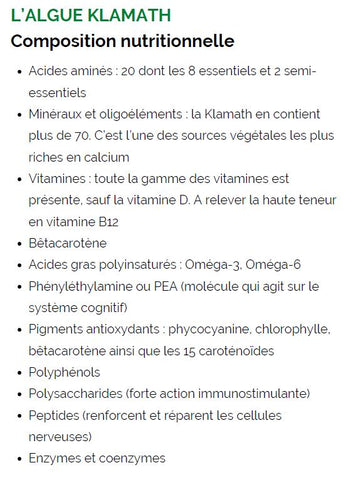
16/07/2023
Spotlight on the queen of algae: Klamath
In the United States, in southern Oregon, flows a high-altitude lake sheltered from all pollution, Upper Klamath Lake. In this exceptional biotope, a small wonder of nature has been developing for millennia: Aphanizomenon Flos-Aquae (AFA) or Klamath algae. Considered by researchers as the most complete food in the world, this microalgae contains more than 115 highly bioavailable micronutrients. Strengthening, revitalizing, and restorative, Klamath contains specific active principles making it an unparalleled algae.
The origins of Klamath
Klamath algae is one of the oldest forms of life to have appeared on our planet. It has survived through all ages, resisting microbes and pollution. Consumed for thousands of years by the Klamath tribe, a Native American people from Oregon, this microalgae was discovered in the 1970s and then marketed as dietary supplements in the United States in 1980. It was not until the mid-1990s that American scientific studies confirmed its benefits. Since 2000, numerous researches have been conducted in Europe, notably at the University of Urbino in Italy. Popularized worldwide, Klamath is now consumed as a dietary supplement, in capsules, tablets, flakes, or powder.
A unique composition
The nutritional and therapeutic virtues of the Klamath algae were first mentioned by Cortés in his logbook of the 16th-century Spanish conquests. With its 115 nutrients, Klamath stands out for the richness of its components: amino acids, essential fatty acids, vitamins, minerals, trace elements, complex carbohydrates, antioxidant pigments, polyphenols, and enzymes.
Phycocyanin and Phenylethylamine: the main active ingredients
Klamath contains two particularly powerful antioxidants that make it unique. These are phycocyanin and phenylethylamine. Phycocyanin, the blue-green pigment that colors Klamath, is a powerful antioxidant that prevents DNA oxidation and regenerates tissues. Phenylethylamine (PEA) is a hormone produced in the brain that stimulates the release of dopamine, a neurotransmitter acting on the central nervous system as a natural "antidepressant." PEA also helps increase alertness and concentration.
Klamath, Spirulina, and Chlorella: the champion is...
Sisters of Spirulina and Chlorella, Klamath is an algae even richer in nutrients. It indeed contains specific active principles that the others do not have.
- 3 trace elements: iodine (essential for proper thyroid function), boron (diuretic), molybdenum (involved in iron fixation)
- Phenylethylamine (PEA)
- Amino acids with photoprotective properties against UVA-UVB
- Plant enzymes that stimulate pancreatic enzymes and facilitate digestion
Due to its recent discovery, Klamath algae have been the subject of fewer clinical studies than Spirulina and Chlorella. However, it confirms its interest in managing a number of pathologies.
Properties and benefits of Klamath
The exceptional composition of Klamath makes it a top superfood, both for prevention and as support for the body.
Antioxidant virtues
Rich in polyphenols, carotenoids, chlorophyll, and vitamin C, Klamath algae have a powerful antioxidant effect and help fight cellular aging. Its amino acids with anti-radical properties also protect cells from UVA and UVB rays. The microalga thus effectively combats oxidative stress caused by excess free radicals in the body.
Stimulates the immune system
The polysaccharides found in large quantities in Klamath algae contain active agents that activate white blood cells. These cells are responsible for detecting and destroying degenerated or virus-infected cells. The immune system then defends itself more easily and quickly, thus preventing viral infections and slowing the development of certain pathologies.
A natural antidepressant
American researchers have discovered a significant concentration of phenylethylamine (PEA) in Klamath algae. PEA is a substance produced by the brain, commonly called the "love molecule" or "joy molecule," responsible for the release of adrenaline and dopamine. This molecule stimulates pleasure centers, thus affecting mood, joy, and emotional well-being.
Stimulates concentration
PEA also boosts brain activity and intellectual abilities. It improves intuition, concentration capacity, memory, energy, and physical and mental endurance. Studies have shown a decrease in behavioral disorders in children, such as hyperactivity, school stress, or dyslexia.
Promotes stem cell production
One of Klamath's great strengths is that it stimulates the production of our own stem cells. These cells can repair damaged organs or tissues by multiplying indefinitely. With age and oxidative stress, this renewal decreases. Klamath promotes the production of these cells and supports the regeneration of organs and tissues.
Detoxifies the body
Klamath algae contains antioxidants that protect our body against heavy metals, radioactive metals, pesticides, and herbicides. Polysaccharides, chlorophyll, and phycocyanin are three molecules that detect metals in tissues and organs, capture them, and then eliminate them through the kidneys, unlike other green algae like Chlorella which only trap heavy metals without eliminating them.
Prevents deficiencies
The exceptional concentration of Klamath in proteins, iron, amino acids, and trace elements, as well as its richness in vitamin B12, makes this algae a highly appreciated food for people on vegetarian and vegan diets. It helps to fill deficiencies in proteins, iron, and vitamin B12 among others.

Klamath: for whom?
Klamath algae can be consumed by everyone. Its richness in nutrients is perfectly suited for the elderly, athletes, students, pregnant or menopausal women, convalescents, deficient vegetarians, malnourished people or those with increased protein needs, or during chronic fatigue. Thanks to phycocyanin, Klamath is also recommended for people suffering from osteoarthritis or inflammatory problems. It is also advised during seasonal changes to strengthen the immune system. In short, Klamath algae can be consumed for its nutritional or curative effects.
How to consume it?
Klamath algae is available in powder, tablet, flake, or liquid form, but it is most commonly found in capsules. In cooking, the blue algae can be incorporated into both sweet and savory dishes. In summer, it can easily be prepared in smoothies, such as the Spinach, Klamath, and Pear smoothie. However, the strong taste of the powdered algae is not suitable for everyone. In that case, opt for Klamath in the form of dietary supplements.



